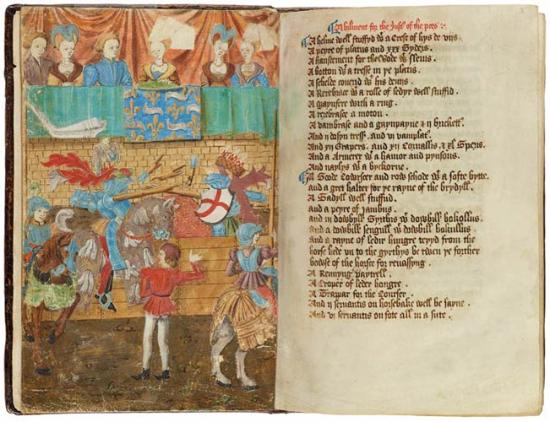
Ordinances of Chivalry, in English and Latin
Purchased, 1931
These men and women seated in a viewing stand watch a joust (in which lances are violently breaking). The two men wear the short gown — as does the squire in red in the foreground — with narrow pleats and raised shoulders. The muscular look is achieved by mahewters, padded rolls that enlarge the upper arms. Women wear fashionable gowns with wide V necks and partlets covering the bosom. (In addition, two of the women cover their fronts with fine linen.) Atop their temples two women wear thick V-shaped burlets, while the other two have butterfly veils that, supported by wires, sail high above their heads.
Peacocks of the Midcentury
In 1435, during the final chapter of the Hundred Years' War, Duke Philip the Good switched sides and supported King Charles VII. By the following year, the English occupation of Paris ended. When Charles VII regained Normandy and Aquitaine in 1453, the long war was finally over. In the ensuing period of peace and prosperity, fashion revived.
These decades saw the last of the houpeland. It continued to be worn by men and women in provincial areas, but in France and Flanders it was appropriate only for formal occasions. Men more often wore the gown: full or knee length, belted at the waist. Over the course of these thirty years, men's gowns, via flaring pleats and ample shoulder padding, assumed a flattering, V-shaped silhouette. While the chaperon remained popular, new hats also arrived.
Women's gowns featured wide V necks with contrasting collars and partlets (plackards worn at the midriff). Headgear atop the temples continued to evolve, growing ever more extravagant. Burlets got thicker and climbed higher. Butterfly veils, supported by wires, floated like sails above ladies' heads.
